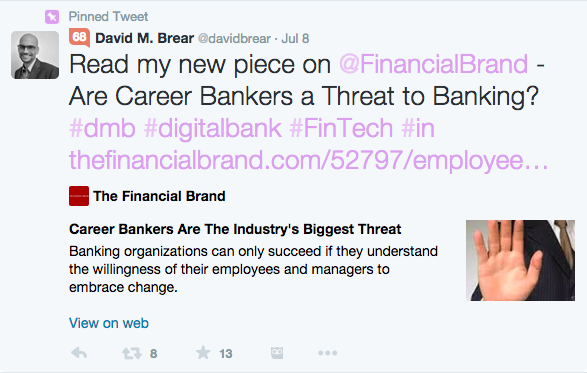How blockchains are laying the groundwork for the next century’s economic growth – not only in the finance sector, but across society as a whole.
Der Bitcoin war das Nonplusultra, wenn es um digitales Geld ging. Der Konkurrent Ether könnte das aber nun ändern – auch weil er mehr kann als Bitcoin. Ether übersprang jetzt eine magische Hürde.
The Ethereum network is a distributed economy like Bitcoin, except it is much, much more powerful. Rick Seeger dives into why you should be paying attention to its popularity.
Quelle: Ethereum: Rise of the World Computer – Silicon Valley Data Science
Ethereum is a contract validating and enforcing system based on a distributed public ledger (or blockchain) such as the one implemented by the Bitcoin cryptocurrency. Yet, Ethereum also features an internal Turing-complete scripting language that can be used to encode advanced transaction types directly into the blockchain. This allows for the deployment of self-enforcing smart contracts (such as joint savings accounts, financial exchange markets, or even trust funds) as well as distributed autonomous organizations (DAOs) that subsist independently of any moral or legal entity. These algorithmical entities are both autonomous and self-sufficient: they charge users from the services they provide so as to pay others for the resources they need (e.g. bandwidth, cpu). Thus, once they have been created and deployed onto the blockchain, they no longer need (nor heed) their creators.
But if DAOs are independently operated — neither owned nor controlled by any given entity — who is actually in charge, responsible for, or accountable for their operations? And if their resources cannot be seized (because DAOs have full sovereignty over them), how can they be required to pay damages for their torts? This talk will analyse the interplay between distributed autonomous organizations and the law, with a view to explore the dangers and opportunities of Ethereum: could this new platform promote the establishment of an entirely decentralized society, or will its disruptive potential eventually be absorbed by the established system?
About Primavera
Primavera De Filippi is a postdoctoral researcher at the CERSA / CNRS / Université Paris II (Panthéon-Assas). She is currently a research fellow at the Berkman Center for Internet & Society at Harvard Law School, where she is analyzing the challenges raised by distributed architectures and multimedia applications in the context of cloud computing and peer-to-peer networks.
Links
Source: https://cyber.law.harvard.edu/events/luncheon/2014/04/difilippi

Photo: Mark Hodson
Every week, we’ll be offering a quick rundown of the most relevant news in finance and technology.
PayPal reached a valuation of $ 50 billion in its first day of trading on the Nasdaq as an independent company since its split from eBay (which had acquired PayPal back in 2002 for $ 1.5 billion). The market clearly sees payments as big business.
Apple Pay went live in the UK. For banks and financial institutions, the message should be clear. Tech companies are taking banking and finance seriously. Meanwhile, Samsung began testing its own mobile payments app in South Korea.
- See also: WiredMoney 2015 Highlights
45% of surveyed Brits say that faster and more convenient payments services could influence their banking choices, even move their account to a new institution. The survey suggests growing consumer demand for real-time payments.
SWIFT published a new paper that explores the potential instability of Bitcoin mining.
Deloitte published a paper earlier this months that investigates how governments and central banks might leverage the best qualities of digital currencies and distributed ledger technologies.
High-profile multinational corporations are beginning to act as their own banks. With the size and scope of corporate treasury departments expanding, managing smart and efficient payments is becoming a fundamental part of running an international business.
Follow Ripple on Twitter
Ethereum, the decentralized application and smart contracting platform prepares to shoot the starting gun, as their Frontier release reaches 99% 98% completion. Miners, who have been waiting a year since the crowdfund, have begun sharpening their GPU pick axes.
[Update: Another bug seems to have been added over night, bringing it back to 98%]
Imagine a day when you want to go meet some friends for a drink. You pull out your iPhone 13, open the decentralized uber app, and using your preferred cryptocurrency, you pay for a smart cab.
The vehicle has no steering wheel. It does not need one. Artificially intelligent driving software issues an offer to pick you up, competing with 50 other smart cabs in the area. The best deal locks in on the blockchain exchange and a few seconds later the cab arrives, ready to facilitate and enhance the rest of your night out.
The door closes behind you as you walk onto your front lawn. The door can only be opened by those with a specific crypto token, which like Bitcoin, can be transferred to your family or friends, as you see fit.
From the inside, it looks more like a club lounge than a taxi, very much like high-end limousines look and feel today, except in the size of a 4-door sedan. Since smart cars virtually never crash, you don’t really need a seat belt, and all chairs are facing the center of the vehicle. You are served a cocktail to get you started as you journey to the restaurant.
Everything in your home, from your toaster to your washing machine, can be controlled digitally and from anywhere in the world. You remember, as you drive to the gathering, that you forgot to start the dryer. No problem, there’s an app for that too. Just approve the right micro transaction on the blockchain with a voice command to your smartwatch.
This future is not hard to imagine. This is only a small glimpse of everything being made possible by technologists today, and the blockchain promises to deliver an essential piece of security and simplicity to the rising Internet of Things.
Utopia or Dystopia?
To some this might seem like a dream land, a place where agreements are completely peer to peer, enforced by mathematics, not by law, nor corruptible human bureaucracies and our biases.
To others, the knowledge that is hard-earned through the daunting insecurities of technology systems and through ubiquitous and scandalous hacks could spell disaster for such a world, especially should control of all human tools be hijacked by malicious actors. The security of our information systems is, therefore, of utmost importance, since this future is near. The Internet of Things at this scale is a reality waiting to happen. The question is, will it be secure?
Well, as far as security in the Age of Information goes, blockchains are very promising. Bitcoin has proven that decentralized networks can hold massive amounts of value. While individual parties may be hackable, such as the graveyard of centralized Bitcoin exchanges and wallets, still the protocol remains whole, and the economy vibrant and growing.
Ethereum is among such blockchain technologies, and it is believed by many to be one of the most promising and anticipated decentralized smart contracting protocols in development today.
Its vision, brought to us by distributed consensus engineer and visionary, Vitalik Buterin, is about to take its first step out of a two-year development cycle that has up until now been confined to test networks.
It will go down in history as having been one of the most successful crowdfunded projects hands down, having raised over US$18 million in September 2014. As of today, it sits in third place as having raised the most money among crowdfunded projects, ever.
Ethereum, of course, is not only being developed by Buterin. The Ethereum community is as international and decentralized as its protocol, composed of hundreds of volunteers and a large operations and development team. It includes Gavin Woods, Stephen Tual, Jeffrey Wilcke and many more. And they are building on the work of many before them, as we all are.
In fact, the term ‚smart contract‚ dates back to 1993, credited to pioneer Nick Szabo.
Are We There Yet?
“Frontier” is the name of the first release of the Ethereum main chain, and it is called that for a reason, as illustrated by a documentation on the release, which states:
“The Frontier is the first live release of the Ethereum network. As such you are entering uncharted territory and you are invited to test the grounds and explore. There is a lot of danger, there may still be undiscovered traps, there may be ravaging bands of pirates waiting to attack you, but there also is vast room for opportunities.”
The document goes on to warn that Frontier is a command-line-heavy release. Those hoping for an easy-to-use interface are advised to “step back, watch from a distance for a while and wait until more user friendly tools are made available,” although there are some user interfaces in development, such as Mist and AlethZero.
This, however, should not discourage miners and tech-savvy entrepreneurs looking for the next gold rush. If there was ever a hot coin to mine, it might be this one.
While there is no official launch date yet — and I would not hold my breath for a “Heads up, we are launching Thursday” — there has been recent speculation that Frontier will launch within the next two weeks or so.
One obvious reason is the milestone barometer that follows the progress of the Frontier release. It was at 98% earlier this July. Now it sits at 99% 98%.
Stephen Tual also made a post on July 15 in which he suggests that the release is very close. Here are two clues he left:
“We’re very happy with the way Olympic [the Frontier testnet pre-release] took shape, so much so that many of the Frontier gotchas (chain reset at Homestead, 10% mining rewards, checkpointing) were deemed unnecessary.”
“Eight days ago we entered feature freeze. Meaning we are focusing exclusively on fixing bugs in the Geth codebase right now, we’re not adding new features anymore.”
Fairlay’s prediction market is also betting on whether “Ethereum frontier goes live before August,” with 113 votes and a roughly a 20% weight towards yes. Participants also seem very confident Frontier will launch before September. [Update: Prediction markets seem to also have shifted over night, this is an updated image]
Ethereum will use a mixed approach to their security protocol, starting off with a miming phase to distribute the ether units of account and then shift towards a proof of stake algorithm. Though details as to exactly when also seem to be scarce and in development.
Tual points out that there is still a “lot of admin processes to deal with: [ensuring] we have a strategy to recover from forks, a well rounded helpdesk, etc.” He adds that, “Once we are happy that Frontier is ‚done‘ and that the aforementioned processes are in place, we’ll publish a blog post explaining the next steps. We still won’t give a date, but at that point miners will want to be sure to be ready.”
Which brings us to mining.
Mine Me Some Ether!
— RC2 mining rig, “‘Olympic‘ edition,” named after the last proof-of-concept Ethereum test release
Tual has published a very detailed “How to Mine Ether” guide and FAQ, where he also describes a GUI for miners called EthMiner. It uses its own algorithm called “EtHash” a “Hashimoto / Dagger hybrid.”
I asked on r/ethereum, “What are my chances of actually mining any Ether on Frontier release, and how would I do it?” I received one particularly insightful response from redditor “playingethereum,” who said:
“The chances are incredibly good if you own a GPU with greater than 1 GB of video memory. You’ll need to set up your miner in advance. Ethereum has a very fast block time (12 seconds), so lots of people will find a couple blocks. The trade off is that the value of the blocks is significantly less than you would expect with bitcoin. For example, a current bitcoin block is worth ($300 * 25 bitcoin) = $7500, while an Ethereum block might be worth about ($3 * 5 ether) = $15.00.”
Keep an eye out for updates on those numbers.
Waiting for the Starting Gun
Some of the popular and anticipated projects waiting for Ethereum to launch include:
- Augur: Decentralized prediction market.
- EtherEx: “Fully Decentralized crypto currency exchange”
- EtherParty: An easy-to-use interface for designing smart contracts, including visual design
Though there are plenty of projects being developed on the sidelines of Ethereum and there’s likely some buried, undiscovered gems, most of them preparing and waiting for the starting gun. Boom.
Source: http://cointelegraph.com/news/114898/ethereum-prepares-for-take-off
Successful partnership is possible, under the right circumstances. Source: McKinsey
In May, McKinsey released a report of their latest findings and advice on potential improvements in banking and payments.
The report points out that the threat of disintermediation looming over banks can be neutralized through the implementation of judicious partnerships and white-labeling of technological products that update aging infrastructure.
“Third-party platforms are making it possible for banks, non-bank financial institutions, payments processors and other organizations to customize cross-border services in ways that go beyond the options offered by traditional correspondent banking arrangements. Ripple Labs, having developed a real-time, cross-border open payment protocol based on recent cryptocurrency technologies, is an example of these new types of third-party platforms. Such innovators allow financial institutions to streamline and improve the service levels and costs of critical steps in the correspondent banking infrastructure, such as message routing and settlement. The speed at which new entrants are evolving, as shown by Ripple’s recent partnership announcement with Earthport, increases the potential for a significant disruption within the industry.”
McKinsey goes on to outline the five criteria for successful partnerships in this sphere:
- Clear partnership strategy. Both partners understand who the customer is and what they expect in terms of service upgrades.
- Strategic fit of partnership strategy. Bother partners understand who the customer is and what they expect in terms of service upgrades.
- Strategic fit of partners. Any relationship between partners must be predicated on trust and a “complementary footprint.”
- Harmonized customer experience.
- Integration between platforms and seamless processes on the customer side, resulting from shared governance and reporting on the business side.
- Aligned incentives. Financial or operational incentives can help to align goals and visions between organizations.
Download the full report.
Follow Ripple Labs on LinkedIn
This is the first in a series of recommendations on who to follow in fintech social media. Stay tuned for more. #FintechFollowFriday
Financial technology is like a busy intersection in a huge city. Banking and finance runs east to west; from the venerable past into the unknown future. Traffic on that road isn’t as fast as it used to be, but it is dense and it stops for no one. Technology is the road that runs north to south; from the misty far-off territory of vision through the gridlock of development and finally into the gritty south industrial areas of implementation.
The place where they come together is packed, confusing, and it’s difficult to hear the message above the noise. These recommendations for who to follow on Twitter can help to establish a known traffic pattern; something that can be anticipated and followed if one gets lost.
-
Bradley Leimer @leimer
Bradley Leimer is the head of innovation at Santander, and actually fills the elusive and difficult-to-define role of a fintech evangelist. His timeline is youthful, with clear interest in quantifying millennials as customers and viewing change as a constant as well as a good. He retweets often, but with an eye toward content curation. If you’re looking for thought leadership and a reading list, look no further.
See also: Santander: Distributed Ledger Tech Could Save Banks $ 20 Billion a Year
-
Claire Cockerton @clairecockerton
Claire Cockerton is CEO and chairwoman of Entiq. Her timeline reflects a love for the possibilities of fintech and the good it can do in the world. She attends fintech events and often shares her thoughts or photos from them, so you can be there without being there, and she’s always involved in the Twitter fintech conversation.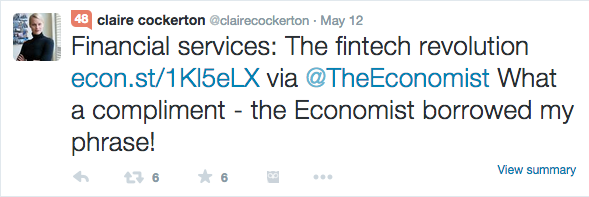
-
Faisal Khan @babushka99
Faisal Khan is the ultimate outside-insider. Khan is known as a consultant in fintech and one of the most accomplished answerer of questions on Quora. His timeline includes his blog posts, his podcasts, and his predictions about the payments market. If you like to think about what’s possible, follow Faisal Khan.
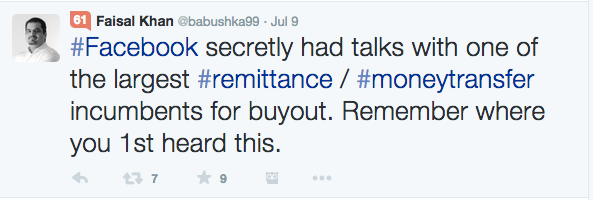
-
David M. Brear @davidbrear
David Brear is the Chief Thinker at the Think Different Group, following up on a stint as director of digital banking at Gartner. Brear tweets an active and lively timeline about payments in the UK, as well as curating links on banking topics. He’s included in the @FinTechMafia and his contributions are often funny or sardonic. If you follow too many dormant or automated accounts, add Brear to wake things up.
See also: Singapore’s Continued Investment in Banking Innovation
-
Brian Knight @BrianKnightMI
Brian Knight is an associate director at the Center for Financial Markets at the Milken Institute. His timeline is varied, not all fintech all the time, but a mix of interest-piquing content that centers on finance and banking. Follow Knight if you enjoy fintech insights with a sprinkle of sarcasm and the occasional joke.
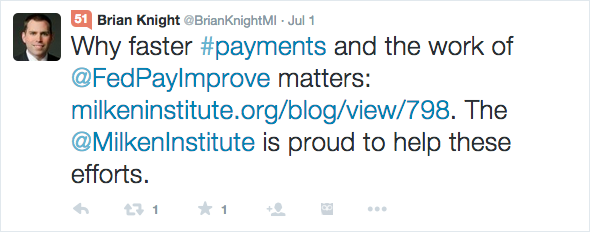
-
Brett King @brettking
Brett King is a an influential voice in fintech that you can actually listen to— thanks to his #1 rated radio show, Breaking Banks. King is also an author, founder, and innovator. His timeline brooks no nonsense, and often aggregates important news from multiple sources. Follow King if you want to feel the pulse of fintech in your timeline every day and have access to some of the best podcasts on the subject of moving money.
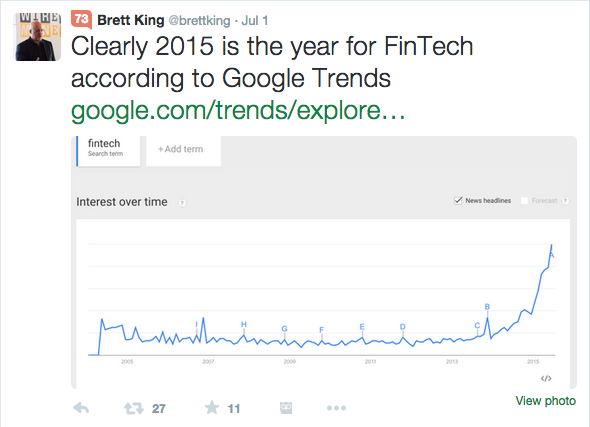 Follow Ripple on Twitter
Follow Ripple on Twitter

Consumers are demanding faster payments in the UK. Photo: Flickr
This is part 1 of our 2-part interview series with Jeremy Light on the future of payments.
Real-time payments is the hottest topic in Europe if not globally, says Jeremy Light, a managing director at Accenture and payments industry expert.
When you think of influential authorities in the payments space, Jeremy instantly comes to mind. As head of Accenture Payment Services in Europe, Africa, and Latin America, Jeremy focuses on strategy, systems integration, and outsourcing.
A prolific thought leader, Jeremy regularly produces groundbreaking industry publications—such as his report, “Digital Payment Transformation”—and also maintains a blog. He was named Accenture’s Inventor of the Year 2015 after being awarded a mobile payments patent in 2014 along with his colleagues.
We recently caught up with Jeremy to get his take on the future of payments.
Ripple Labs: Everyone seems to be talking about real-time payments these days.
Jeremy Light: I would say probably the hottest topic in Europe if not globally is real-time payments. The Euro Banking Association (EBA) is focused on it. So is the European Central Bank (ECB). At the end of last year, the ECB issued a challenge to the banking industry in Europe—for them to develop a cohesive vision for building real-time payments infrastructure. They didn’t want to see disparate systems being set up around Europe that didn’t work together.
The EBA, which also performs a clearing function, set up a forum earlier this year across Europe to spark a discussion on real-time payments. But even without the extra nudge, we’re seeing progress in quite a few countries around the world, where banks are investigating how they can set up a real-time clearing system.
Last year, Finland issued a request for information (RFI), which described the national payment system there as quickly becoming obsolete. The Netherlands just announced that they’re going to set up real-time payments. Dutch banks plan to have real-time solutions set up by 2019. The EBA itself has just issued a blueprint for a pan-European instant payment infrastructure to be implemented from 2016 to 2018.
RL: So real-time is clearly on everyone’s minds. What are the biggest challenges moving forward? What are the major roadblocks?
Jeremy: Well, one major challenge is getting banks not only to adopt new technology and infrastructure, but also offer these products to their customers. Even now, there are banks around Europe that will say that their customers aren’t asking for real-time payments, that same day or next day payments is good enough.
RL: It kind of sounds like how Internet providers here in the US will say that their customers don’t want faster broadband speeds.
Jeremy: Right. Consider the UK, where we’ve had the Faster Payments System since 2008, which, by the way, is now growing very strongly. Despite having the capabilities all these years, banks haven’t really promoted or marketed real-time payments. That’s not necessarily the fault of the banks either. A lot of small businesses, until recently, have been more than content with same day payments. But I would say that in the past 18 months, there’s been a big shift in attitude. We can’t pinpoint exactly why, but customers are now demanding real-time payments.
As a result, those banks that can’t offer guaranteed real-time payments 24/7/365, they’re starting to notice that their customers are complaining because they see this service being offered by competitors. They see others doing it, that it’s possible and that it’s happening. So there’s definitely been a wave of change regarding expectations in the last year or so.
Here in the UK, we have a lot of upstart banks, called challenger banks, encouraged by the government’s drive to open up competition in the banking industry. These new banks realize that they have to offer a real-time payments proposition because if they don’t, they’ll be at a huge disadvantage.
RL: Which makes sense. Everything else in our world today is on demand. The Internet has wired us for instant gratification.
Exactly. We suspect that this shift in expectations is part of the rise of the digital age. People’s lives are governed by their smartphones and they experiences they get with Google, Amazon, and Apple, where everything is immediate and instantaneous. It’s pushing banks to change their stance.
Consider a scenario if a bank in Europe wanted to offer mobile payments because their customers are demanding it. If i send you a payment by mobile and you get a message—Jeremy just sent you $ 15.
But then you look at your bank account and you don’t see the money, it’s a problem. It becomes a source of uncertainty and anxiety. You don’t know when your money will arrive or even if it will arrive. And banks get that. They realize that they can’t offer mobile payments unless it’s in real-time and it’s a sea change that’s occurring across Europe.
So most banks, most countries are realizing that they need to implement these systems because if you think about it, it’s the natural progression. It’s evolution. Like you said, everyone is used to real-time in every other aspect of their lives. It just makes sense. When people send you an email, they want an instant response. If I ask you a question, I want an answer. I don’t want it tomorrow. I want it immediately.
RL: Given all of that, where do you think distributed ledgers fit into the equation?
It’s an interesting question. The distributed consensus ledger technology that Ripple offers and that blockchain technologies offer is coming along at just the right time when banks are looking at real-time payments. So there’s an immense amount of interest in what these innovations have to offer.
The caveat of course, is that these technologies still need to mature, particularly if we’re talking about the blockchain. If you look at Bitcoin, the maximum transactions right now is maybe around 3 or 4 per second. Then you look at Visa, which can process around 45,000 transactions per second. Bitcoin also isn’t technically real-time since it takes at least ten minutes to confirm a transaction. That isn’t to say these issues can’t be addressed, but right now, the technology hasn’t advanced yet and in terms of businesses offering real solutions, I haven’t seen any credible candidates. I don’t see it as this incredible technology that offers a solution for the immediate future. On the other hand, Ripple confirms transactions in seconds, which, I expect, is what banks are looking for.
RL: You make a great point about Visa. A lot of people will say, look, we can already do real-time with a centralized ledger and so they don’t understand the appeal of a distributed system.
Jeremy: That’s a key question. Why distributed ledgers? For one, a distributed solution enforces integrity and commonality versus one central ledger that everyone can access.
At the same time, central clearing and settlement is very efficient. Most clearing and settlement systems today can handle very high volume and they rarely have issues. Apart from very occasional hiccups, such as in the UK wire system last year, we haven’t really had issues regarding resilience.
Still, having these central, proprietary systems adds a lot of complexity and cost on the bank side. There’s a lot of different systems and these systems don’t interoperate with each other. This adds to operational issues and operational processes. So if we consider long term costs, a distributed ledger could conceivably be a better, more efficient solution, and there’s certainly the potential to do that. That’s why these technologies are so interesting for banks.
We’re still in the discovery phase around cryptotechnologies, distributed consensus ledgers. What will be intriguing to banks and financial institutions is to figure out how they can leverage the advantages of these innovations.
RL: Maybe this is an obvious questions, but what are the immediate benefits of real-time payments, given that customers are now demanding it as a service?
From a consumer point of view, there are two main advantages. The first is that you have real-time availability of funds. If I give my daughter a pound coin, she can immediately go and buy an ice cream, rather than in a few hours or the next morning. When you have real-time availability of funds, you’re much more flexible with what you can do.
The second advantage is the ability to provide a seamless customer experience. We’ve noticed that in the UK, if a bank has delays of even just 10 minutes, customers service call volumes go up significantly because someone was sent money, but when they go to the ATM, it hasn’t arrived yet.
People enjoy a sense of certainty. They like knowing that a job is done so they can forget about it. Today, because PayPal is connected to the Faster Payments System, you can move money between your bank account and PayPal account in real-time. The same goes for people who have accounts at different institutions, you can send money from one bank to another instantaneously. If you initiate a transaction and you see that it’s left one account and it hasn’t arrived in another, it’s painful.
That’s the customer proposition. It’s instant gratification, essentially cashless cash. If you give cash to someone, a $ 20 bill, that’s it. The transaction is done and you can move on. That’s the beauty of real-time payments.
And this is exactly the trend we are seeing. In the UK, we predict volumes on the Faster Payments System to double or triple in the next few years, and they are already at over a billion payments per year.
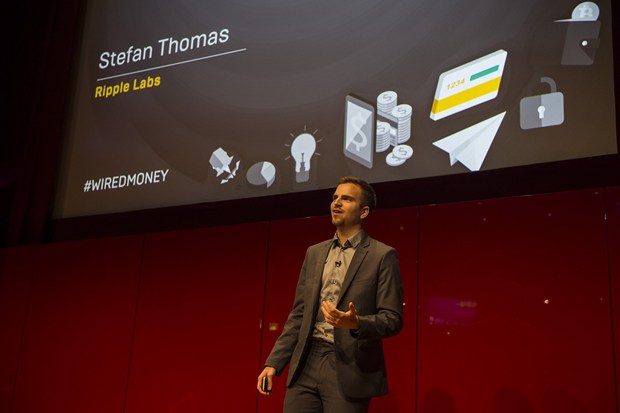 WiredMoney 2015 was held on July 8 at the British Museum in London, and as audiences have come to expect, the event attracted presenters and speakers from power players and new entrants to the world of finance.
WiredMoney 2015 was held on July 8 at the British Museum in London, and as audiences have come to expect, the event attracted presenters and speakers from power players and new entrants to the world of finance.
Incumbents like Visa shared the stage with disruptors like Bitcoin, and Ripple Labs presented on the integration of legacy banking with distributed ledger technology. Newcomers to the industry showed off their proposals in the pitch sessions on the BBVA Ventures Startup Stage.
In this wealth of ideas and chorus of voices, there are a few highlights that stand out:
Ismail Ahmed, CEO and founder of WorldRemit, reasoned that cash is being replaced in much of the developing world by mobile phones; a process that brings historically unbanked people into the global economy for the first time.
Key quote: “45% of Kenya’s GDP flows through M-Pesa.”
Jonathan Vaux, executive director of innovations partnering at Visa Europe, represented his company as a friendly incumbent willing to partner with new players in financial technology and ready to adapt.
Key quote: “By working together we will succeed together.”
Peter Smith, CEO of Blockchain, presented on the concept of crowdsourced and provable identity that could be verifiable online. He proposed that this idea would be of particular use in countries without state-issued ID as well as in places where verification is costly or time-consuming.
Key quote: “Really at its core, Bitcoin is just an open access database that anyone can write to.”
Stefan Thomas, CTO of Ripple Labs, presented on the Internet of Value; the concept of integrating siloed financial institutions through Ripple’s partnership with banks to create a flat and completely connected payments world.
Key quote: “We believe this point in the future has finally come.”
The common thread that emerged in nearly every presentation was one of partnership; the necessity for new technology and legacy financial institutions to adopt and adapt to one another for the good of consumers all over the world.
Technologies are emerging that change irrevocably the way people all over the world identify themselves, move money, and make payments. As our own Stefan Thomas put it, this technology is not a future possibility; it is a current reality.






